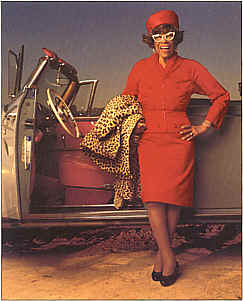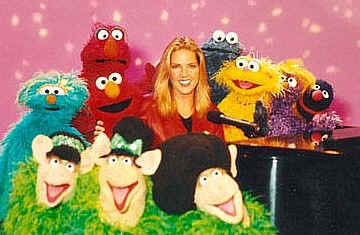|
Over an insinuating bossa nova beat Claus Ogerman's ominously beautiful orchestral arrangement for Diana Krall's recording of "Dancing in the Dark" rolls in like overlapping waves on a rising tide ahead of an approaching coastal storm. As the music thickens, and the heady romantic promise of a couple on the dance floor vowing to "face the music together" gathers force, Ms. Krall's darkly inviting voice steals into the arrangement. Her aura is sensual but also faintly surly and a little guarded. She wraps the song in mystery. As it comes to an end, the tide turns and slowly starts to roll away, fading out on waves that gradually recede into a murky void.
"Dancing in the Dark" is the entrancing centerpiece of Ms. Krall's newest album, "The Look of Love" (Verve), perhaps the most satisfying collection of orchestrated popular standards to be released since the heyday of Frank Sinatra and Ella Fitzgerald. The song, composed in 1931 by Arthur Schwartz and Howard Dietz for the show "The Band Wagon," turns on the lines "We're waltzing in the wonder of why we're here/ Time hurries by/We're here, then we're gone."

That recording, with its balance of beauty and terror, became a personal touchstone to which I returned again and again in the wake of the events of Sept. 11. The lyric's uncertainty and fatalism voiced a commonly felt mood of despair: the fearful intimation that even if there was a future, it still might be too bleak to contemplate.
But the music, with its connection to the eternal, also reminded me of humanity's capacity for beauty. And the combination of Ms. Krall's cool, modernist approach and the lush romantic elegance of the orchestration evoked a comforting continuity between now and then, an assurance that in a pop climate overwhelmingly devoted to disposable novelty, some things are made to last.
Popular music, especially since the birth of rock 'n' roll and the coalescence of an affluent teenage culture, has been all about newness: new technologies, new styles, new trends, fresh young voices and bodies defying and canceling out the past. In recent years the pop obsession with youth and perpetual revolution has finally abated somewhat as baby boomers who invested a spiritual faith in the redemptive power of rock have watched their children embrace vapid bubble gum boy bands and teenage pinups.
As the Rock and Roll Hall of Fame codifies and sanctifies an institutionalized rebellion, it is paradoxically more apparent how much rock 'n' roll owed to the culture it purported to overthrow: melody for one thing, plus a belief in romantic love as the common denominator of most song lyrics. It's hardly surprising that the generation that once tried to erase the past in the half-joking boast "hope I die before I get old" now longs to keep the spirit of its youth alive in the face of more musical nihilism than prophets of punk rock envisioned 25 years ago.
When you crunch the numbers today, the yawning generation gap of the 60's and 70's seems insignificant. Consider that Bob Dylan at 60 is 33 years older than Eminem but only 15 years younger than Tony Bennett. Both Mr. Dylan and Mr. Bennett are now revered musical patriarchs who share more common ground than Mr. Dylan does with today's rappers and boy bands. On Mr. Bennett's fine new blues album, "Playin' With My Friends" (Columbia RPM), he performs with Ms. Krall, Sheryl Crow, Bonnie Raitt, K. D. Lang, Billy Joel and others.
At 75, Mr. Bennett has replaced Frank Sinatra as the reigning king in one area of American pop in which age has always been venerated and continuity celebrated: the small perpetually struggling cabaret community in which singers perform deep into their 70's and sometimes beyond. It's an economically fragile world whose demise is predicted year after year yet never comes.
One reason for its hardiness is that many cabaret performers really do get better as they age, pouring their experience and musical knowledge into a repertory of popular standards that seems never to lose its capacity to inspire. The greatest songs of Kern, Berlin, Porter, the Gershwins, Rodgers (with his collaborators Hart and Hammerstein), Mercer, Arlen and maybe a dozen others have a solidity and naturalness that make them amazingly available to contemporary interpretation.
Hearing great pop singers in their 70's interpreting songs of young love, you are reminded that humans resemble redwood trees. We're not just the crusty bark but all the rings beneath, alive and existing simultaneously. To hear an aging but still vital singer reaching into the various layers to pull out particular moods and refract them through experience can be an extraordinarily rich aesthetic and emotional experience.
Among the performers now in their 70's whose singing is emotionally deeper and dramatically more nuanced than it was in their supposed prime are Mr. Bennett, Barbara Cook, Blossom Dearie, Rosemary Clooney and Bobby Short. Conventional wisdom has it that singers like these are the last of a vanishing breed of performer who matured during the golden age of the Broadway musical and the tail end of the swing era, before high-fidelity and electric rhythm redefined pop singing and songwriting. Certainly each of these singers is an irreplaceable treasure. But will their eventual passing mean the end of it all? I don't think so. There are enough younger contenders to ensure the perpetuation if not the economic health of a tradition that is still evolving.
At the forefront is Ms. Krall, now the best-selling jazz artist in the country. Because she is blond, white and Canadian (from British Columbia), her success has sparked considerable resentment among the jazz cognoscenti. Jazz purists question her hipness factor. But so far in her career this singer and pianist has taken the high road. Instead of selling out to a larger record company and attempting to cross over into the pop realm, Ms. Krall has remained with Verve, a jazz label, and recorded only high- quality material. In performance this shy vocal minimalist who echoes Peggy Lee and Nat (King) Cole is the farthest thing from a narcissistic pop-jazz diva. In her quiet way she is also an original: a subtly swinging interpreter who holds back feeling until it's about to explode, then lets it out in mercurial, vibrant flashes.

Nostalgia has a way of making the past look rosier than it really was. It's easy to forget that during the 1950's, the much-touted golden age of the LP and of pop and jazz singing, the airwaves were dominated by trashy novelties and insipid pap even shallower than what's popular today. Nor is there reason to expect the general aesthetic level of pop to improve anytime soon. Mass entertainment has always been essentially escapist. Given the sheer tonnage of pop junk nowadays, it would be easy to conclude that high-quality music is being buried under a sea of garbage. But isn't it more likely that the amount of lasting work is roughly the same as it always was, and that the surrounding acreage of junk has expanded?
I would like to believe that even now the pop music that deserves to last will find a way to endure, however precariously.
-- Stephen Holden, New York Times
|